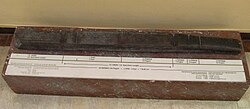Eckhard Unger
- View a machine-translated version of the German article.
- Machine translation, like DeepL or Google Translate, is a useful starting point for translations, but translators must revise errors as necessary and confirm that the translation is accurate, rather than simply copy-pasting machine-translated text into the English Wikipedia.
- Do not translate text that appears unreliable or low-quality. If possible, verify the text with references provided in the foreign-language article.
- You must provide copyright attribution in the edit summary accompanying your translation by providing an interlanguage link to the source of your translation. A model attribution edit summary is
Content in this edit is translated from the existing German Wikipedia article at [[:de:Eckhard Unger]]; see its history for attribution. - You may also add the template
{{Translated|de|Eckhard Unger}}to the talk page. - For more guidance, see Wikipedia:Translation.
Eckhard Unger (Landsberg an der Warthe, 11 April 1884 – 24 July 1966) was a German assyriologist.
Unger who was the curator of the Istanbul museum described the remains of Balawat Gates that are still in the Istanbul Museum. Unger was fully aware that the major parts of the gates were in London and Paris as he had visited both locations and discussed them with the respective curators.[1]

In 1916, as curator of the Archeological Museum of Istanbul, he identified and described a copper-alloy object in the museum collection as an ell or measuring rod from Nippur. Dating to the first half of the third millennium BC or even earlier, possibly the oldest known measuring device, it supposedly defines the Sumerian cubit at about 518.6 millimetres. During World War I he made a first detailed research in Basilica cistern (yerebatan Sarnıcı) at İstanbul.[2]
Published works
The many published works of Eckhard Unger include among others:
- Zum Bronzetor von Balawat. Beiträge zur Erklärung und Deutung der assyrischen Inschriften und Reliefs Salmanassars III (thesis) Leipzig: Eduard Pfeiffer 1913
- Zwei babylonische Antiken aus Nippur [s.l.] 1916. (Publikationen der Kaiserlich Osmanischen Museen)
- Katalog der babylonischen und assyrischen Sammlung Kaiserlich osmanische Museen Istanbul: Ihsan 1918
- Die Wiederherstellung des Bronzetores von Balawat [Leipzig]: [Hinrichs], 1920
- Welt und Mensch im alten Orient Berlin: Witting [n.d.]
- Hettitische und aramäische kunst [Berlin] [1923]
- Sumerische und akkadische Kunst Breslau: Hirt 1926
- Assyrische und Babylonische Kunst Breslau: Hirt 1927
- Das Stadtbild von Assur Leipzig: Hinrichs 1929 (Der alte Orient, 27:3)
- Babylon. Die heilige Stadt nach der Beschreibung der Babylonier 1931 (2nd ed. Berlin: De Gruyter 1970)
References
- ^ Zum Bronzetor von Balawat, Beiträge zur Erklärung und Deutung der assyrischen Inschriften und Reliefs Salmanassars III, Eckhard Unger, retrieved 4 September 2014
- ^ Acta praehistorica et archaeologica Volumes 7–8. Berliner Gesellschaft für Anthropologie, Ethnologie und Urgeschichte; Ibero-Amerikanisches Institut (Berlin, Germany); Staatliche Museen Preussischer Kulturbesitz. Berlin: Bruno Hessling Verlag 1976 p. 49
- v
- t
- e











